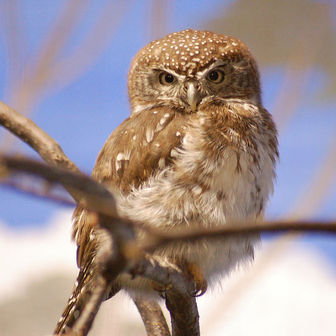Pearl-spotted Owlet
Pearl-spotted Owlet is a common and easily seen bird in open woodland and savannah. It nests in a hole in a tree, such as a disused barbet nest, laying 2-4 eggs.

The Pearl-spotted Owlet is classified as Least Concern. Does not qualify for a more at risk category. Widespread and abundant taxa are included in this category.
The Pearl-spotted Owlet (Glaucidium perlatum) is an owl which breeds in Africa south of the Sahara. This species is a part of the larger grouping of owls known as typical owls, Strigidae, which contains most species of owl. The other grouping is the barn owls, Tytonidae. Pearl-spotted Owlet is a common and easily seen bird in open woodland and savannah. It nests in a hole in a tree, such as a disused barbet nest, laying 2-4 eggs. More
* Pearl-spotted Owlet videos, photos & sounds on the Internet Bird Collection This entry is from Wikipedia, the leading user-contributed encyclopedia. More
Pearl-spotted owlet perched on branch Pearl-spotted owlet perched on branchPrint factsheet Facts - Also known as: Pearl-spotted owl Synonyms: Glaucidium passerinum, Strix perlata French: Chevêchette Perlée Kingdom Animalia Phylum Chordata Class Aves Order Strigiformes More
One of sub-Sahara’s commonest owls, the pearl-spotted owlet is characterised by two black patches with white rims on the back of the head, which appear as false eyes. This distinctive feature may help this diminutive owl to evade predators by making it appear larger than it actually is (2) (4). Otherwise, the plumage is cinnamon-brown, with white spots on the upperparts, and white on the underside with broad brown streaks. More
Like many birds of prey, the female pearl-spotted owlet can be up to 30% larger than the male - DISTRIBUTION Africa south of the Sahara, Senegal and Gambia, east to Chad and the Central African Republic HABITAT Open savannahs and semi-open woodlands DIET Rodents, beetles, frogs, crickets, and small birds BREEDING The favored nest is an abandoned woodpecker nest-hole. More
The Pearl-spotted owlet is common in many parts of Southern Africa, where it can be found in open woodland, thorn savannah and bushveld. Unlike most owls, it hunts in the day as well as the night, feeding mainly on invertebrates, with small mammals and birds making up most of the remainder of its diet. It mainly nests in tree holes, usually made by barbets or woodpeckers. It lays 2-4 eggs, which are incubated mainly by the female. More
The Pearl-spotted Owlet is a Southern African bird that belongs to the strigidae bird family group which includes birds such as Typical owls. The description for the Pearl-spotted Owlet (Latin name Glaucidium perlatum) can be found in the 7th Edition of the Roberts Birds of Southern Africa. The Glaucidium perlatum can be quickly identified by its unique Roberts identification number of 398 and the detailed description of this bird is on page 261. More
a picture of the Pearl-spotted Owlet on page 272. The Pearl-spotted Owlet belongs to the family of birds classified as strigidae. In the previous edition of Roberts (ie 6th edition) the Pearl-spotted Owlet was called the Pearl-spotted Owl The map of the Kruger you see on this page shows the areas (coloured orange) where this bird has been identified. The basic information was provided by the Avian Demographic Unit based at UCT and I created the maps from that information ... More
Pearl-spotted Owlet is a common and easily seen bird in open woodland and savannah. It nests in a hole in a tree, such as a disused barbet nest, laying 2-4 eggs. The Pearl-spotted Owlet (Glaucidium perlatum) is an owl which breeds in Africa south of the Sahara. This species is a part of the larger grouping of owls known as typical owls, Strigidae, which contains most species of owl. The other grouping is the barn owls, Tytonidae. More

Original source: Isidro Mart
Author: Isidro Mart
Permission: Some rights reserved
Family : Strigidae
Genus : Glaucidium
Species : perlatum
Authority : (Vieillot, 1818)
